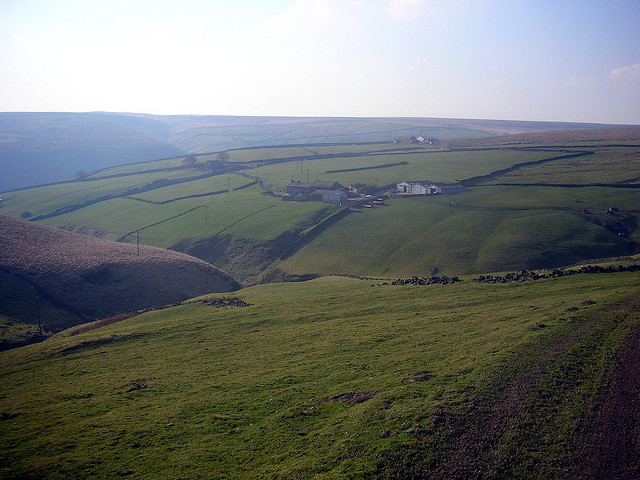The Following is excerpted from Land: A New Paradigm for a Thriving World, published by North Atlantic Books.
A proper community is a commonwealth: a place, a resource, an economy. It answers the needs, practical as well as social and spiritual, of its members—among them the need to need one another. The answer to the present alignment of political power with wealth is the restoration of the identity of community and economy.
—Wendell Berry
Every being on this planet is imbued with consciousness simply by virtue of their existence. Each being has an innate nobility, a dignity that can’t be tarnished, though the suffering of our human experience often blinds us to this reality. We’re all intimately connected to all that is, because we’re a part of life. When we seek to own a part of nature, we usually do so because we see ourselves as separate from nature. Yet we are deeply interconnected to one another and the Earth. And since every human being needs land in order to simply exist, doesn’t it follow that the value that land freely offers to all human beings would best be freely shared with all?
Aside from the ethical implications that arise when we don’t share the value of land with one another, we’ll continue to experience a host of challenging issues as long as the value of land remains privatized. Do we wish to solve poverty, reverse the process of cultural degeneration, and halt the cancerous destruction of nature? Then we’re wise to begin to share the gifts of nature with one another.
While it’s infeasible in practical terms for us to share every aspect of nature with one another, it’s entirely possible for us to share the monetary value that human beings assign to nature. Once we begin to share this value with one another, we have the opportunity to unleash a cultural, technological, ecological, and even spiritual renaissance that will liberate us in ways we can’t even begin to imagine! Once we truly begin to share these financial resources, we can create a world where everyone can have their basic needs met, where nature is no longer exploited, where people are given the greatest opportunities for self-expression, and where life is not just an array of setbacks, but a beautiful canvas that allows for a greater unfolding of human potential.
If we’re to share the value of land, it’s certainly not necessary to abolish the exclusive use of land. On the contrary, the forcible seizing of land from individuals by government without just compensation deserves to be called tyranny. The fundamental thing we need to abolish is the mechanism by which people unfairly profit from land.
The solution is so simple that it’s most often overlooked: Property owners merely need to pay the communities from which they receive benefits through their exclusive use of land the exact market value of the benefits that they receive.
Property owners—and all those with a vested interest in properties, including, and perhaps even especially, financial institutions—benefit enormously from the communities in which their properties are located. Profits from land are not only unearned but also deplete community resources, which need to be replenished periodically. This replenishment can best be accomplished through a land leasehold model in which land is owned in common, even as it is privately used, since the rental value of land reflects the combined value of all the natural and social benefits that people receive through their possession and exclusive use of land. When land users pay significant portions of the rental value of land to their local communities, they rightfully reimburse their communities. When land users make such contributions to their local communities, they make what I call community land contributions.
Community land contributions are similar to so-called land-value taxes, a method by which property owners are taxed on the value of the land they possess. Unlike community land contributions, however, land-value taxes are still rooted in the paradigm of private land ownership: They use the selling price of land as a tax base to determine the tax obligation of the landowner; to reference the selling price of land instead of its rental value psychologically already implies private land ownership as opposed to community land stewardship that allows for private land use. The word tax also implies that the people being taxed have to part with something that belongs to them, since people pay taxes on their incomes, their sales, their capital gains, and so forth. The term land-value tax, therefore, implies that land users are being taxed on their land value, which, of course, is incorrect, because the value of land belongs to the communities that create that value. Community land contributions, on the other hand, appropriately emphasize that land is a community good and that people ought to contribute to their communities if they choose to use it exclusively.
A community land contribution model would allow us to move from a monopoly model on land toward a competitive leasing model in such a way that people can continue to use land exclusively if they so wish, except that now other people are reimbursed for their exclusion. When community land contributions are made at frequent intervals (for example, annually) and as a fraction of the market rental value of land (for example, 80 percent of rental value), land users begin to pay their communities for their use of land instead of other human beings or institutions (such as the seller from whom the land was bought or the bank that provides the mortgage). Such ongoing payments to our local communities have the effect of lowering the selling price of land in relation to the rental value of land: They tend to approximate the market rental value of land and will never be greater than what land users would pay had they otherwise leased the land on the open market.
Historically, there have been periods when people shared the value of land with their local communities due to the economic policies of the time. Too often, however, these economic policies didn’t go far enough, and the resulting wealth wasn’t always shared in ways that remedied poverty and decreased wealth inequality. One of the more modern examples is Hong Kong, a former British Crown colony in Southeast Asia. Since the end of the Second World War, Hong Kong has experienced an economic boom on a meteoric scale; within just a few decades, this small, relatively unknown city became one of the world’s dominant centers of high finance. Since all land was considered to belong to the British Crown, the British colonial government leased land to private entities. These leaseholds have allowed Hong Kong to collect a certain amount of land value and have also allowed the government to maintain relatively low tax rates.
Although it’s often cited as a model of laissez-faire economic growth due to its low income and corporate tax rates, its minimal interference in economic affairs, and its lack of sovereign debt, Hong Kong practiced, in effect, a form of conventional capitalism while simply preventing—at least to a small extent—its residents from profiting too much from land. Yet even though Hong Kong’s leasehold model represents a step in the right direction, it remains flawed since land-value assessments are not updated annually to reflect the current market value of land; leasehold revenues therefore bear little relationship to yearly increases in land values. On the other hand, because Hong Kong is a relatively small island of prosperity, it has also had to deal with massive immigration from main land China, and because Hong Kong’s land values were not widely shared with all Hong Kong residents, this influx created massive poverty problems in Hong Kong as well. We can only imagine what kind of prosperity Hong Kong might achieve for all its residents if it were to fully share the value of its land.
In other examples, today every resident of Alaska receives a relatively modest Basic Income from the value of oil. Norway does something similar, though on a much bigger scale, with its Government Pension Fund Global, a fund entirely financed through revenues from Norway’s petroleum sector and currently the largest pension fund in the world. The island of Taiwan was able to achieve rapid economic success without causing severe wealth inequality once it implemented land-reform policies. Central California’s transformation from dust bowl to breadbasket of America in the late 1800s is another example of natural wealth shared for public benefit: The State of California constructed vast irrigation infrastructures financed entirely through the taxation of resulting land-value increases. Whenever society chooses to safeguard nature for the benefit of current and future generations, the wealth that becomes available to society is immense: Every time the value of land is shared, the economy balances, nature is conserved, land speculation is inhibited, and society becomes more prosperous overall.
So how can we implement economic policies that share the value of land? The problem is that in most nations around the world the value of land is already privatized: If communities were to suddenly impose land contributions upon existing property owners, property owners would end up having to pay twice for their use of land—first to the previous owner (from whom they bought land) and then again to their local communities. It is a challenging ethical dilemma: On the one hand, no one should be asked to pay twice for something they only agreed to pay for once. On the other hand, it’s appropriate for property owners to reimburse their local communities for their exclusive use of land—if they don’t, everyone ends up being worse off in the end.
Of course, governments could financially compensate existing property owners with government bonds: Fred E. Foldvary—the aforementioned economist who correctly timed the 2008 recession in 1997—recommends this approach. To implement a compensation plan would require a large-scale, societal transformation, however: All levels of government and society would have to work together to accomplish such a monumental undertaking. While it’s certainly possible, such a transformation is unlikely given society’s current lack of awareness regarding the underlying economic realities that drive our choices and behaviors. What other options might we have at our disposal in order to create social change? We demonstrate a deep understanding of the process of social change when we realize that it isn’t an idea alone that matters, but the practice of it, no matter how small the implementation of our idea may be at first. In other words, we are called to implement new models of land stewardship that render our existing model of land ownership obsolete.
One such new model was conceived by the late Adrian Wrigley, a Cambridge academic who envisioned a model based on land-use rights. What’s interesting about his model is that land-use rights enable communities to collect the value of land while also permitting private land use at the same time. In essence, land-use rights are voluntarily created between a community and a property owner: When real estate is put up for sale, either the local government or a community land trust advances funds to the new buyer to pay for the land-value portion of the sales price. In exchange for these funds, the buyer receives a tradable land-use right for the property. According to Wrigley: “The owner of the property is required to pay an index-linked sum to the community [for his land-use right] on a monthly basis in perpetuity. The land-value mortgage paperwork is handled by a bank, and when completed, the government pays the bank and the bank lodges the [land-use right] in return. The bank has no further involvement with the arrangement.” A property tied to a land-use right should be exempt from property taxes, and community land contributions made by the title holder should ideally be tax-deductible on state and federal levels as well.
Unlike taxes, which are enforced by governments upon property owners and tenants alike, land-use rights involve a voluntary arrangement between an individual and the local community to which the individual belongs. This creates a mutually beneficial bond for everyone involved: The community recognizes the voluntary nature of the transaction and tends to appreciate the willingness of the land user to reimburse the community for the exclusive use of land. And since land users will have to financially invest in their local communities on an ongoing basis through community land contributions, they’re more likely to become interested in maintaining the well-being of their communities. The land user, meanwhile, will no doubt appreciate the ability to use land without having to pay a substantial amount upfront.
We’ll look at land-use rights in greater detail in later chapters. But before we do that, let’s take a closer look at our current tax system, because taxes, as we shall see, profoundly influence the way we interact with one another. Currently, people pay very little for the benefits they receive through their possession of land to the communities that provide these benefits. And so, to pay for public works, governments are forced to tax the production and consumption activities of their citizens instead.
Since tax systems create behavioral incentives for billions of people worldwide, and since our economies by and large currently tend to incentivize the unequal sharing of land, we can effectively remedy a whole plethora of economic, social, and ecological issues by sharing the value of land. Once we do, we can effectively change how billions of people behave economically, socially, and ecologically. If this conclusion is indeed true, we can potentially make the greatest difference for our planet and for humanity by focusing our efforts on eliminating tax systems and encouraging people to share nature’s gifts instead.
Teaser image by Michael Spiller, courtesy of Creative Commons license.














